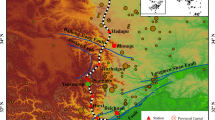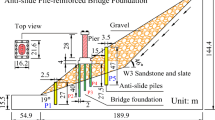Abstract
A shaking table test for a bridge foundation reinforced by anti-slide piles on a silty clay landslide model with an inclined interlayer was performed. The deformation characteristics of the bridge foundation piles and anti-slide piles were analyzed in different loading conditions. The dynamic response law of a silty clay landslide with an inclined interlayer was summarized. The spacing between the rear anti-slide piles and bridge foundation should be reasonably controlled according to the seismic fortification requirements, to avoid the two peaks in the forced deformation of the bridge foundation piles. The “blocking effect” of the bridge foundation piles reduced the deformation of the forward anti-slide piles. The stress-strain response of silty clay was intensified as the vibration wave field appeared on the slope. Since the vibration intensified, the thrust distribution of the landslide underwent a process of shifting from triangle to inverted trapezoid, the difference in the acceleration response between the bearing platform and silty clay landslide tended to decrease, and the spectrum amplitude near the natural vibration frequency increased. The rear anti-slide piles were able to slow down the shear deformation of the soil in front of the piles and avoid excessive acceleration response of the bridge foundation piles.
Similar content being viewed by others
References
Adachi T, Kimura M and Tada S (1989), “Analysis on the Preventive Mechanism of Landslide Stabilizing Piles,” Proceedings of the 3rd International Symposium on Numerical Models in Geomechanics, Vol. III, Niagara Falls, Canada, pp. 691–698.
Chen CY and Martin GR (2002), “Soil-Structure Interaction for Landslide Stabilizing Piles,” Computers and Geotechnics, 29(5): 363–386. https://doi.org/10.1016/S0266-352X(01)00035-0
Chen ZY and Li YY (2015), “Boundary Deformation of Model Container Design,” Earthquake Resistant Engineering and Retrofitting, 37(5): 106–112. (in Chinese)
China Railway First Survey and Design Institute (1999), Railway Engineering Geology Manual, Beijing: China Railway Publishing House, China.
Du YB, Yuan CB, Wang YD and Tao YJ (2012), “Major Geological Hazard and Geological Alignment of Chengdu-Lanzhou Railway,” Journal of Railway Engineering Society, 29(8): 11–15. (in Chinese)
GB/T 50081-2019 (2019), Standard for Test Methods of Concrete Physical and Mechanical Properties, Ministry of Construction of the People’s Republic of China, Beijing: China Architecture and Building Press, China. (in Chinese)
Gratchev IB, Sassa K, Osipov VI, Fukuoka H and Wang GH (2007), “Undrained Cyclic Behavior of Bentonite-Sand Mixtures and Factors Affecting It,” Geotechnical and Geological Engineering, 25(3): 349–367.
Hungr O, Leroueil S and Picarelli L (2014), “The Varnes Classification of Landslide Types, an Update,” Landslides, 11(2): 167–194. https://doi.org/10.1007/s10346-013-0436-y
Ilankatharan M and Kutter B (2010), “Modeling Input Motion Boundary Conditions for Simulations of Geotechnical Shaking Table Tests,” Earthquake Spectra, 26(2): 349–369.
Koutsabeloulis NC and Griffiths DV (1989), “Numerical Modelling of the Trap Door Problem,” Geotechnique, 39(1): 77–89.
Liang FY, Jia YJ, Sun LM, Xie W and Chen HB (2017), “Seismic Response of Pile Groups Supporting Long-Span Cable-Stayed Bridge Subjected to Multi-Support Excitations,” Soil Dynamics and Earthquake Engineering, 101: 182–203.
Liang FY, Jia YJ, Xie W, Sun LM and Chen HB (2019), “Transverse Response of Pile Group Foundation Supporting Long-Span Cable-Stayed Bridge Under Uniform and Non-Uniform Excitations,” Soil Dynamics and Earthquake Engineering, 121: 57–74.
Liang R and Zeng S (2002), “Numerical Study on Soil Archingmechanism in Drilled Shafts for Slope Stabilization,” Soil and Foundation, 42(2): 83–92. https://doi.org/10.3208/sandf.42.2_83
Li CY, Lv LX, Wang XG and Li XN (2019), “Late Quaternary Slip Behavior of the Yushu Fault and the 2010 Ms 7.1 Yushu Earthquake, Eastern Tibetan Plateau,” Journal of Structural Geology, 118: 284–298. https://doi.org/10.1016/j.jsg.2018.11.004
Li JB, Zhang HR and Li ZQ (2011), “Theoretical Study on Similarity Relation of Small Scale Subgrade Shaking Table Test Model,” Advanced Materials Research, 255–260: 3354–3360. https://doi.org/10.4028/www.scientific.net/AMR.255-260.3354
Li MX and Yang ZQ (1996), “Development and Applications of Technology on Seismic Simulation Shaking Table,” World Earthquake Engineering, 12(2): 49–54. (in Chinese)
Lin ML and Wang KL (2006), “Seismic Slope Behavior in a Large-Scale Shaking Table Model Test,” Engineering Geology, 86: 118–133.
Lin YL, Cheng XM and Yang GL (2018), “Shaking Table Test and Numerical Simulation on a Combined Retaining Structure Response to Earthquake Loading,” Soil Dynamics and Earthquake Engineering, 108: 29–45. https://doi.org/10.1016/j.soildyn.2018.02.008
Liu ZJ, Zhang Z, Wen L, Tapponnier P, Sun J, Xing X, Hu G, Xu Q, Zeng L, Ding L, Ji C, Hudnut KW and Woerd J (2009), “Co-seismic Ruptures of the 12 May 2008, Ms 8.0 Wenchuan Earthquake, Sichuan: East-West Crustal Shortening on Oblique, Parallel Thrusts Along the Eastern Edge of Tibet,” Earth and Planetary Science Letters, 286(3–4): 355–370. https://doi.org/10.1016/j.epsl.2009.07.017
Lou ML, Wang WJ, Zhu T and Ma HC (2000), “Soil Lateral Boundary Effect in Shaking Table Model Test of Soil-Structure System,” Earthquake Engineering and Engineering Vibration, 20(2): 30–36. (in Chinese)
Luo Z, Zhu YP, Han KQ, Wang DY and Liu YQ (2016), “Review and Prospect for Dynamic Similitude Theory and Its Applications in the Structure Vibration,” Journal of Mechanical Engineering, 52(23): 114–134. (in Chinese) https://doi.org/10.3901/JME.2016.23.114
Martin GR and Chen CY (2005), “Response of Piles due to Lateral Slope Movement,” Computers and Structures, 83(1): 588–598. https://doi.org/10.1016/j.compstruc.2004.11.006
Nian TK, Chen GQ, Luan MT, Yang Q and Zheng DF (2008), “Limit Analysis of the Stability of Slopes Reinforced with Piles Against Landslide in Nonhomogeneous and Anisotropic Soils,” Canadian Geotechnical Journal, 45(8): 1092–1103. https://doi.org/10.1139/T08-042
Rao PP, Zhao LX and Chen QS (2019), “Three-Dimensional Limit Analysis of Slopes Reinforced with Piles in Soils Exhibiting Heterogeneity and Anisotropy in Cohesion,” Soil Dynamics & Earthquake Engineering, 121: 194–199.
Shen DJ and Lu XL (2010), “Experimental Study on the Mechanical Property of Microconcrete in Model Test,” China Civil Engineering Journal, 43(10): 14–21. (in Chinese) https://doi.org/10.15951/j.tmgcxb.2010.10.013
Wu DH, Liu YQ, Li HB, Xia X, Peng B and Shen H (2020), “Shaking Table Tests on Dynamic Amplification and Failure Mechanism of Layered Rock Slopes Under Seismic Actions,” Chinese Journal of Rock Mechanics and Engineering, 39(10): 1945–1956. (in Chinese)
Yang C (2012), “Analysis of the Controlling Factors of Chengdu-Lanzhou Railway Location in 5.12 Wenchuan Earthquake-Stricken Areas,” Proceedings of the 1st International Workshop on High-Speed and Intercity Railways, Vol. 147, Heidelberg, Germany, pp. 385–394. https://doi.org/10.1007/978-3-642-27960-7_33
Yang CW (2013), “Study on Seismic Dynamic Characters of Rock Slopes and System Including Formation Mechanism of Landslides, Stability Discrimination of Slope and Assessment of Hazard Scope of Landslide for Slope of Bedrock and Overburden Layer,” Doctoral Thesis, Southwest Jiaotong University, China. (in Chinese)
Yang Z, Liao HJ and Lou KY (2002), “Experimental Study of the Full Curve of the Stress-Strain Relationship for Microconcrete,” Engineering Mechanics, 19(2): 90–94. (in Chinese)
Ye HL, Zheng YR, Li AH and Du XL (2012), “Shaking Table Tests on Stabilizing Piles of Slopes Under Earthquakes,” Chinese Journal of Geotechnical Engineering, 34(2): 251–257. (in Chinese)
Zhao JF, Gao B, Fan KX, Zhou PF and Shen YS (2019), “The Design and Verification Test of Dynamic Model Boxes for Mountain Tunnels Crossing a Bad Geology Region,” Journal of Vibration and Shock, 38(8): 80–87.
Zhao MH, Chen BC and Liu JH (2006), “Analysis of the Spacing Between Anti-Slide Piles Considering Soil-Arch Effect,” Central South Highway Engineering, 31(2): 1–3. (in Chinese)
Zhang T, Gao B, Fan KX, Zheng Q, Huang HF, Shen YS and Zhao HD (2018), “Study on Flexible Material in the Sidewall of Rigid Model Box in Shaking Table Test,” Chinese Journal of Rock Mechanics and Engineering, 37(10): 2415–2424. (in Chinese) https://doi.org/10.13722/j.cnki.jrme.2018.0471
Zhou DP, Xiao SG and Xia X (2004), “Discussion on Rational Spacing Between Adjacent Anti-Slide Piles in Some Cutting Slope Projects,” Chinese Journal of Geotechnical Engineering, 26(1): 132–135. (in Chinese) https://doi.org/10.1007/BF02911033
Zhou F, Xu Q, Liu HX and Wang L (2016), “An Experimental Study of Dynamic Response Characteristics of Slope with Horizontal Weak Interlayer Under Earthquake,” Rock and Soil Mechanics, 37(1): 133–139. (in Chinese) https://doi.org/10.16285/j.rsm.2016.01.016
Zhuang YZ, Chen Y, Chen B, Wang SZ and Han YT (2016), “Shaking Table Test on Boundary Effect of Steel Box for Pile Soil Interaction Research,” Journal of Fuzhou University (Natural Science Edition), 44(4): 504–509. (in Chinese)
Zou ZY, Lei D, Jiang GL, Luo B, Chang SZ and Hou CP (2020), “Experimental Study of Bridge Foundation Reinforced with Front and Back Rows of Anti-Slide Piles on Gravel Soil Slope Under El Centro Waves,” Applied Sciences, 10(9): 3108. https://doi.org/10.3390/app10093108
Acknowledgement
This research was supported by the Sichuan Science and Technology Program (Grant No. 2023NSFSC0894) and Major Project of the Science and Technology Research and Development Program of the Ministry of Railways of China (Grant No. Z2012-061).
Author information
Authors and Affiliations
Corresponding author
Additional information
Supported by: Sichuan Science and Technology Program under Grant No. 2023NSFSC0894, Major Project of the Science and Technology Research and Development Program of the Ministry of Railways of China under Grant No. Z2012-061
Rights and permissions
About this article
Cite this article
Lei, D., Xiao, H., Ran, J. et al. Experimental study on seismic reinforcement of bridge foundation on silty clay landslide with inclined interlayer. Earthq. Eng. Eng. Vib. 23, 193–207 (2024). https://doi.org/10.1007/s11803-024-2233-0
Received:
Accepted:
Published:
Issue Date:
DOI: https://doi.org/10.1007/s11803-024-2233-0




